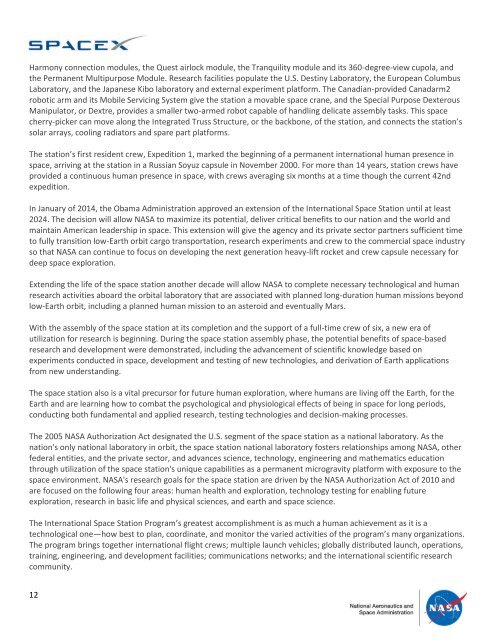spacex_nasa_crs-6_presskit
You also want an ePaper? Increase the reach of your titles
YUMPU automatically turns print PDFs into web optimized ePapers that Google loves.
Harmony connection modules, the Quest airlock module, the Tranquility module and its 360-degree-view cupola, and<br />
the Permanent Multipurpose Module. Research facilities populate the U.S. Destiny Laboratory, the European Columbus<br />
Laboratory, and the Japanese Kibo laboratory and external experiment platform. The Canadian-provided Canadarm2<br />
robotic arm and its Mobile Servicing System give the station a movable space crane, and the Special Purpose Dexterous<br />
Manipulator, or Dextre, provides a smaller two-armed robot capable of handling delicate assembly tasks. This space<br />
cherry-picker can move along the Integrated Truss Structure, or the backbone, of the station, and connects the station’s<br />
solar arrays, cooling radiators and spare part platforms.<br />
The station’s first resident crew, Expedition 1, marked the beginning of a permanent international human presence in<br />
space, arriving at the station in a Russian Soyuz capsule in November 2000. For more than 14 years, station crews have<br />
provided a continuous human presence in space, with crews averaging six months at a time though the current 42nd<br />
expedition.<br />
In January of 2014, the Obama Administration approved an extension of the International Space Station until at least<br />
2024. The decision will allow NASA to maximize its potential, deliver critical benefits to our nation and the world and<br />
maintain American leadership in space. This extension will give the agency and its private sector partners sufficient time<br />
to fully transition low-Earth orbit cargo transportation, research experiments and crew to the commercial space industry<br />
so that NASA can continue to focus on developing the next generation heavy-lift rocket and crew capsule necessary for<br />
deep space exploration.<br />
Extending the life of the space station another decade will allow NASA to complete necessary technological and human<br />
research activities aboard the orbital laboratory that are associated with planned long-duration human missions beyond<br />
low-Earth orbit, including a planned human mission to an asteroid and eventually Mars.<br />
With the assembly of the space station at its completion and the support of a full-time crew of six, a new era of<br />
utilization for research is beginning. During the space station assembly phase, the potential benefits of space-based<br />
research and development were demonstrated, including the advancement of scientific knowledge based on<br />
experiments conducted in space, development and testing of new technologies, and derivation of Earth applications<br />
from new understanding.<br />
The space station also is a vital precursor for future human exploration, where humans are living off the Earth, for the<br />
Earth and are learning how to combat the psychological and physiological effects of being in space for long periods,<br />
conducting both fundamental and applied research, testing technologies and decision-making processes.<br />
The 2005 NASA Authorization Act designated the U.S. segment of the space station as a national laboratory. As the<br />
nation's only national laboratory in orbit, the space station national laboratory fosters relationships among NASA, other<br />
federal entities, and the private sector, and advances science, technology, engineering and mathematics education<br />
through utilization of the space station's unique capabilities as a permanent microgravity platform with exposure to the<br />
space environment. NASA's research goals for the space station are driven by the NASA Authorization Act of 2010 and<br />
are focused on the following four areas: human health and exploration, technology testing for enabling future<br />
exploration, research in basic life and physical sciences, and earth and space science.<br />
The International Space Station Program’s greatest accomplishment is as much a human achievement as it is a<br />
technological one—how best to plan, coordinate, and monitor the varied activities of the program’s many organizations.<br />
The program brings together international flight crews; multiple launch vehicles; globally distributed launch, operations,<br />
training, engineering, and development facilities; communications networks; and the international scientific research<br />
community.<br />
12


